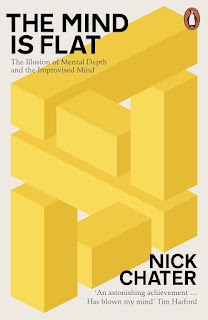His work in the field is extensive, including co-authoring books and numerous papers on the human mind and rationality, challenging the whole theoretical basis of psychology and linguistics with ideas around the flat mind and language as a social construct.
The Flat Mind
In The Flat Mind (2018) starts with a quote from Dennett and presents a thought-provoking theory about human cognition and challenges the conventional belief in the depth and complexity of human thought, arguing instead, that our minds operate on a much more superficial level than traditionally thought. According to his theory, human thinking relies heavily on immediate perceptions and the present context, rather than on deep, abstract reasoning about the world. The mind is not a collection of specialised modules or faculties for different cognitive functions. Instead, he argues the mind is ‘flat’ and there are no true cognitive modules, just patterns of activation over a common coding base.
Chater proposes that rather than processing and manipulating detailed internal knowledge, our minds interpret and react to current sensory data. This approach suggests that much of our cognitive processing is less about drawing from a rich, detailed internal database of knowledge and more about improvising responses based on immediate environmental cues.
The Flat Mind shifts the focus from the idea of the mind as a deep, introspective processor to a more surface-level, reactive entity. This concept has implications for our understanding of memory, reasoning, and decision-making, suggesting that these processes are more context-dependent and less introspective than previously believed.
An important point is that the mind does appear to both read and speak one word at a time and perception has limited visual acuity and colour perception. In addition, he makes the even stronerg claim that the mind is a hoax which we play on ourselves.
Bayesian Brain Hypothesis
As we don't have unlimited cognitive resources, our decision-making exhibits ‘bounded rationality’ using heuristics and rules of thumb rather than optimal rationality and so questions the idea that cognition involves constructing rich mental representations or models of the world. Cognition emerges from simple processes operating over compressed sensory inputs. The brain essentially performs Bayesian inferences or similar probabilistic calculations to interpret sensory data and make decisions, continually updating beliefs based on new evidence. A key idea is that, in the absence of mental representations, human perception and cognition is geared towards efficiently compressing and encoding sensory information into simple codes.
In essence, Chater believes cognition arises from Bayesian probability updating over compressed sensory inputs by a flat, general-purpose mind, not specialised modules or rich mental representations. His perspective challenges many traditional assumptions in cognitive science. Visual perception is the most important of the senses and he sees thinking as largely an extension of perception.
The Language Game
In The Language Game (2022), co-authored with Morten Christiansen, he presents a radical, thought-provoking exploration of how language works and its role in human society. He argues that language originated in communicative charades then develops into other more complex forms of linguistic communications and argues against the common belief that language is a complex code passed down through generations. Instead, language is a form of social negotiation that is constantly evolving. This allows our linguistic abilities develop from social interaction rather than being hard-wired into our brains through deep-seated biological evolution. The book delves into how we use words to navigate our social worlds, construct complex ideas, and solve problems together and challenges traditional linguistic theories and provides insights into the dynamic, ever-changing nature of language as a product of social processes.
Discussion
He considers the rise of Large Language Models as a confirmation of his position. Like LLMs, there are no hidden depths and nothing lurks below the surface. In fact, those constructs are misconceived as stories we tell ourselves about cognition. Our imaginations tell stories and we carry this over into views about cognition, imagining that we work from deep, pre-conceived ideas and reason, when in fact we generate words in the moment and on the fly. Just as there are no hidden depths in LLMs, there are no ghosts in the machine in our minds, no Freudian psychotherapeutic phantoms like the ego, id, superego or Jungian archetypes. There is nothing of substance in our unconsciousness, as it does not exist as traditionally framed. Our imaginations see unconsciousness as a delving down to hidden depths but there are no depths, no creatures of the deep to be found. Like Hume, Parfit and Strawson, he recognises that we are storied-selves but these stories are largely imagined, narrative fictions.
Bibliography
Chater, N. (2018). The Flat Mind. Penguin
Chater, N. (2022). The Language Game. Penguin












































